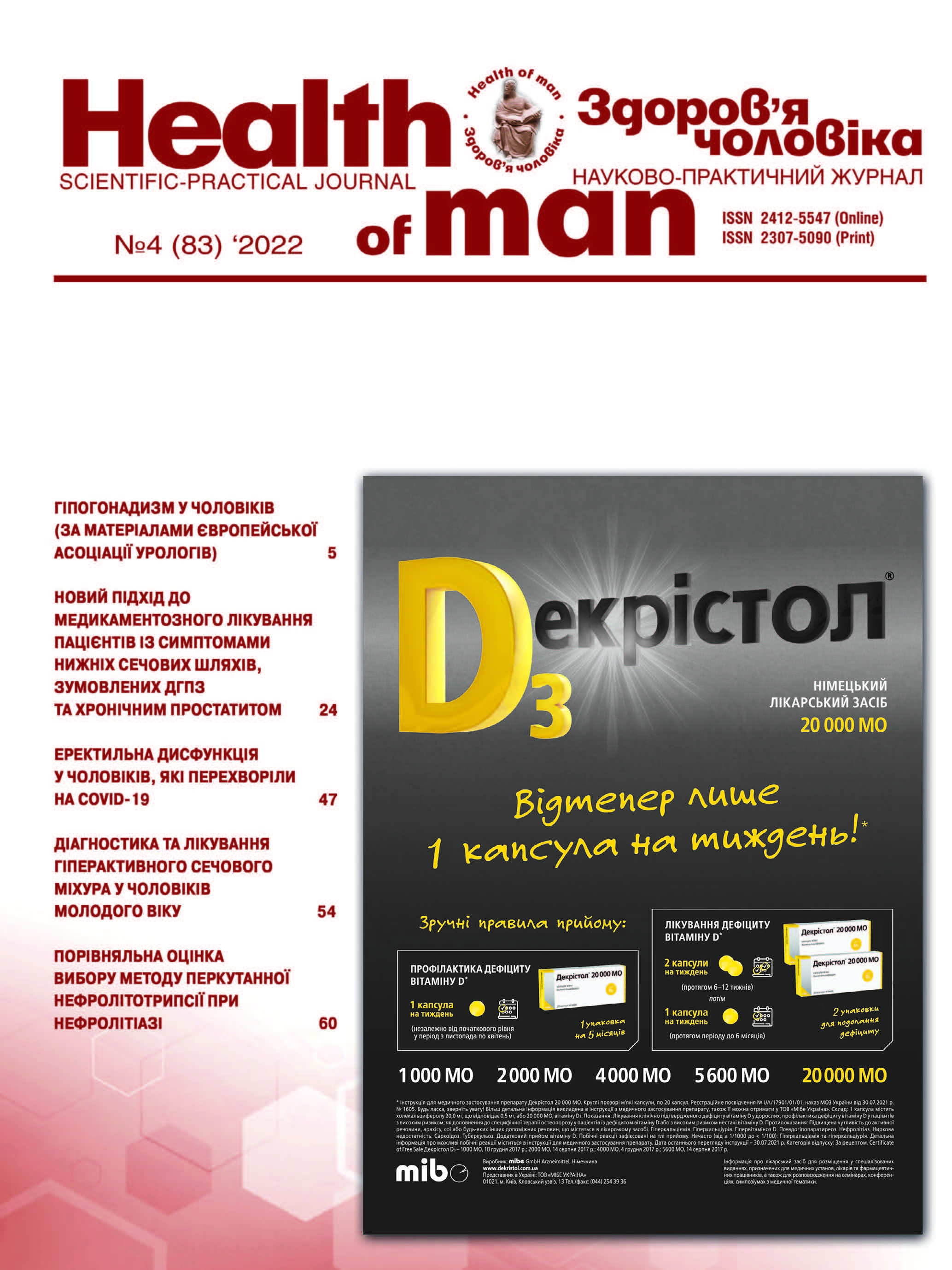Hypercrystalluria as a Factor in the Development of Urine Stone Disease, Diagnosis and Directions of Treatment
##plugins.themes.bootstrap3.article.main##
Abstract
Under the action of exogenous, androgenic, genetically determined factors, the metabolism of stone-forming salts of calcium, phosphorus, magnesium, oxalates, uric acid in the blood serum and their active excretion by the kidneys to the state of hypersaturation (oversaturation) is disturbed) urine is formed. When the level of crystallization inhibitors is disturbed, a saturated salt solution crystallizes with the formation of microliths. The formation of stones in the kidneys is possible only in the presence of «building material» – supersaturated saturated urine, therefore, hyperoxaluria is a pre-stone condition. Treatment measures should be aimed at correcting mineral metabolism in the body after establishing the type of hyperoxaluria using laboratory tests: salt transport, calcium load, dietary test – low-calcium diet, thiazide test and determination of the mineral composition of the removed (removed) stone.
Genetically consequential conditions (10–15%) count about 30 varieties in which the main sign or symptom in the manifestation of the disease is urolithiasis. Unfortunately, congenital tubulopathies are not sufficiently studied, so the treatment is symptomatic, in some cases simultaneous kidney and liver transplantation options are possible.
Clinically, 4 main forms of hypercrystalluria are distinguished: hypercalciuria, hyperoxaluria, hyperuricuria, phosphaturia and mixed forms of crystalluria. Acquired forms of hypercrystalluria, of which they are absorptive (type II intestinal hyperabsorption – absorptive hypercalciuria and absorptive hyperoxaluria), are of main clinical interest, which is characteristic of the course of calcium-oxalate urolithiasis. Metaphylaxis of calcium-oxalate urolithiasis is formed on the basis of these data.
##plugins.themes.bootstrap3.article.details##

This work is licensed under a Creative Commons Attribution 4.0 International License.
Authors retain the copyright and grant the journal the first publication of original scientific articles under the Creative Commons Attribution 4.0 International License, which allows others to distribute work with acknowledgment of authorship and first publication in this journal.
References
Alyaev Yu.G. Egshatyan LV, Rapoport LM, Lartsova EV. Hormonal and metabolic disorders as a systemic factor in the formation of urinary stones. Urol. 2014;(5):35–9.
Apolikhin OI. Early diagnosis of the risk of developing calcium oxalate form of urolithiasis. Urol. 2017;(3):5–8.
Voshchula VI. Urolithiasis: etiopathogenesis, diagnosis, treatment and metaphylaxis: a guide. Minsk: Zimaletto; 2010. 220 p.
Hajiyev NK. Metaphylaxis of urolithiasis: a new look, modern approach, mobile implementation. Urology. 2017;(1):124–9.
Golovanov SA, Sivkov AV, Anokhin NV. Hypercalciuria: principles of differential diagnosis. Man Medicine. 2015;54:86–92.
Golovanov SA, Sivkov AV, Drozhzheva VV, Anokhin NV. Metabolic risk factors and the formation of urinary stones. Study I: the effect of calciuria and uricuria. Experimental wedge urol. 2017;(1):52–7.
Derkach IA. The value of the intestine in the development of urolithiasis. News of medicine and pharmacy. Gastroenterol. 2015;527:33–7.
Derevyanko TI, Bobrovsky RN, Romanenko ES. On the issue of prevention of calcium oxalate urolithiasis. 2015. 84 p.
Dzeranov NK. Clinical and laboratory parameters in patients with urolithiasis in the presence and absence of primary hyperparathyroidism. Urol. 2013;(6):14–8.
Egshatyan LV, Mokrysheva NG, Huseyn RT. Calciuria is a metabolic marker for various conditions and diseases. Urology. 2017;(5):132–8.
Imamverdiev SB. The possibility of the influence of epidemiological risk factors in the formation of urolithiasis. Therapeutic Archive. 2016;88(3):68–72.
Bush AV. Mineralogical composition of stones, risk factors and metabolic disorders in patients with calcium oxalate urolithiasis. Urol. 2017;(4):22–6.
Paronnikov MV. Metaphylaxis of urolithiasis in metabolic syndrome [abstract]. St. Petersburg: VPO Military Medical Academy named after S.M. Kirov; 2014. 27 p.
Shestaev AYu, Protoshchak VV. Metaphylaxis of oxalate urolithiasis in patients with metabolic syndrome. Experiment wedge urol. 2014;(3):123–7.
Aggarwal KP, Narula S, Kakkar M, Tandon C. Nephrolithiasis: molecular mechanism of renal stone formation and the critical role played by modulators. Biomed Res Int. 2013;2013:292953. doi: 10.1155/2013/292953.
Assimos DG, Holmes RP. Role of diet in the therapy of urolithiasis. Urol Clin North Am. 2000;27(2):255–68. doi: 10.1016/s0094-0143(05)70255-x.
Bergsland KJ, Zisman AL, Asplin JR, Worcester EM, Coe FL. Evidence for net renal tubule oxalate secretion in patients with calcium kidney stones. Am J Physiol Renal Physiol. 2011;300(2):F311–8. doi: 10.1152/ajprenal.00411.2010.
Cho ST, Jung SI, Myung SC, Kim TH. Correlation of metabolic syndrome with urinary stone composition. Int J Urol. 2013;20(2):208-13. doi: 10.1111/j.1442-2042.2012.03131.x.
Giardina S, Scilironi C, Michelotti A, Samuele A, Borella F, Daglia M, Marzatico F. In vitro anti-inflammatory activity of selected oxalate-degrading probiotic bacteria: potential applications in the prevention and treatment of hyperoxaluria. J Food Sci. 2014;79(3):384–90. doi: 10.1111/1750-3841.12344.
Grases F, Costa-Bauza A, Prieto RM, Conte A, Servera A. Renal papillary calcification and the development of calcium oxalate monohydrate papillary renal calculi: a case series study. BMC Urol. 2013;13:14. doi: 10.1186/1471-2490-13-14.
Lange JN, Wood KD, Wong H, Otto R, Mufarrij PW, Knight J, et al. Sensitivity of human strains of Oxalobacter formigenes to commonly prescribed antibiotics. Urol. 2012;79(6):1286–9. doi: 10.1016/j.urology.2011.11.017.
Milošević D, Batinić D, Turudić D, Batinić D, Topalović-Grković M, Gradiški IP. Demographic characteristics and metabolic risk factors in Croatian children with urolithiasis. Eur J Pediatr. 2014;173(3):353–9. doi: 10.1007/s00431-013-2165-6.
Ortiz-Alvarado O, Miyaoka R, Kriedberg C, Moeding A, Stessman M, Monga M. Pyridoxine and dietary counseling for the management of idiopathic hyperoxaluria in stone-forming patients. Urol. 2011;77(5):1054–8. doi: 10.1016/j.urology.2010.08.002.
Perinpam M, Ware EB, Smith JA, Turner ST, Kardia SL, Lieske JC. Effect of Demographics on Excretion of Key Urinary Factors Related to Kidney Stone Risk. Urol. 2015;86(4):690–6. doi: 10.1016/j.urology.2015.07.012.
Sakhaee K. Epidemiology and clinical pathophysiology of uric acid kidney stones. J Nephrol. 2014;27(3):241–5. doi: 10.1007/s40620-013-0034-z.
Schnedler N, Burckhardt G, Burckhardt BC. Glyoxylate is a substrate of the sulfate-oxalate exchanger, sat-1, and increases its expression in HepG2 cells. J Hepatol. 2011;54(3):513–20. doi: 10.1016/j.jhep.2010.07.036.
Shoag J, Halpern J, Goldfarb DS, Eisner BH. Risk of chronic and end stage kidney disease in patients with nephrolithiasis. J Urol. 2014;192(5):1440–5. doi: 10.1016/j.juro.2014.05.117.
Skolarikos A, Straub M, Knoll T, Sarica K, Seitz C, Petřík A, et al. Metabolic evaluation and recurrence prevention for urinary stone patients: EAU guidelines. Eur Urol. 2015;67(4):750–63. doi: 10.1016/j.eururo.2014.10.029.
Tiselius HG. Metabolic risk-evaluation and prevention of recurrence in stone disease: does it make sense? Urolithiasis. 2016;44(1):91–100. doi: 10.1007/s00240-015-0840-y.





